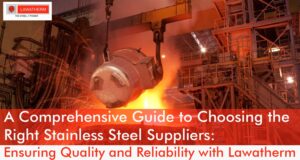High-capacity induction furnaces are built to handle intense heat and continuous operation. With rising demand in steel melting, selecting the right induction furnace cooling system is not optional—it’s essential.
If you’re running a foundry or steel plant, you already know overheating can cause downtime, equipment damage, and even safety risks. So how do you choose a cooling system that keeps your furnace running smoothly without fail?
Let’s break it down.
Why Cooling Matters in Induction Furnaces
An induction furnace works by generating high-frequency currents that heat metal directly. This process is fast and clean, but it produces extreme temperatures—often above 1,600°C. Without a proper cooling setup, internal components like the coil, yokes, and terminals can degrade quickly.
Choosing the right induction furnace cooling system means better furnace temperature control, longer equipment life, and fewer shutdowns.
Ask yourself, is your current system enough to prevent overheating in peak production?
Key Elements of an Effective Cooling System
To decide what system you need, start by understanding the core elements:
1. Water Cooled Cable
The water cooled cable carries high current into the induction coil. But it also generates heat. If the water flow isn’t steady or the design is outdated, the cable may overheat, reducing current flow and risking failure.
Look for cables with:
- Flexible copper core
- Reinforced outer hose
- Leak-proof terminals
Lawatherm offers high-quality water cooled cable systems made for heavy-duty furnace use. They’re tested for high pressure and temperature stability.
2. Flow Full Cone Nozzles
These nozzles are critical for cooling coils and internal furnace walls. A flow full cone nozzle delivers a consistent, even spray pattern—covering more area with less water.
When paired with good water pressure, they prevent localized hotspots. Choose nozzles that:
- Withstand scale build-up
- Maintain pattern under pressure variation
- Are easy to clean or replace
Lawatherm supplies precision-made flow full cone nozzles for consistent furnace cooling and reduced maintenance.
3. Coil Cooling Channels
The induction coil itself needs direct water contact to keep temperatures within limits. Coil cooling is usually done through built-in copper tubes.
Check for:
- Uniform channel spacing
- Proper inlet and outlet configuration
- Flow rate suited for your furnace size
Neglecting coil cooling can cause deformation or insulation failure. Make sure the water inlet temperature is monitored and kept below the safe threshold.
Types of Cooling Systems
There are three main types of induction furnace cooling systems. Choosing the right one depends on your furnace size, melting rate, and operating hours.
1. Open-Loop Cooling
Water is drawn from an external source and discharged after passing through the system.
Pros:
- Simple setup
- Lower cost
Cons:
- Wastes water
- Risk of scaling if water is hard
- Limited temperature control
Best for small furnaces with short melting cycles.
2. Closed-Loop Cooling
Water circulates in a sealed system, often with a heat exchanger or cooling tower.
Pros:
- Reuses water
- Stable water quality
- Better furnace temperature control
Cons:
- Higher initial cost
- Needs regular cleaning
This is ideal for mid to high-capacity steel melting units.
3. Hybrid Systems
Combines both open and closed systems with filtration and temperature control features.
Use this if:
- You’re running multiple furnaces
- You can’t afford unexpected downtime
- Water quality varies by season or source
Lawatherm provides tailored cooling systems that match furnace size and duty cycle without overcomplication.
Choosing What’s Right for You
Ask yourself a few direct questions:
- What’s the maximum temperature my furnace reaches?
- How many tons of metal do I melt per hour?
- How long is each melting cycle?
- Is water quality a concern at my site?
- How often do I need to shut down for maintenance?
These answers guide whether you need just a water cooled cable upgrade, better flow full cone nozzles, or an entire system overhaul.
Also consider adding:
- Temperature alarms
- Flow rate meters
- Backup pumps
These features may seem minor, but they make the difference between planned maintenance and emergency shutdowns.
Why Partner with Lawatherm?
Lawatherm specializes in induction furnace components designed for long-term use in demanding steel melting environments. From water cooled cable assemblies to flow full cone nozzles, we offer products that deliver consistent performance under pressure.
Our team works with steel plants of all sizes. We recommend solutions based on actual data, not guesswork.
When you choose Lawatherm, you’re not just buying parts—you’re upgrading reliability.
Final Thoughts
Choosing the right induction furnace cooling system isn’t just about specs. It’s about matching the cooling need to the heat load of your furnace. Whether it’s upgrading your water cooled cable, installing better flow full cone nozzles, or switching to a closed-loop system, the goal is always the same: stable furnace temperature control and overheating prevention.
Start by reviewing your current setup. Look for weak spots. And don’t wait for a failure to make improvements.
Lawatherm is here to help you stay ahead of downtime—because the cost of cooling is far less than the cost of stopping.




